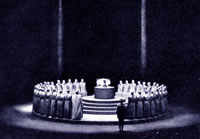"True to his intentions, Wieland approached Parsifal through an analytic scenario which he set out as "Parsifal's Cross: A Psychological Pattern" [see diagram above]. This was a diagram showing how the opera's events moved towards and then away from the peripeteia [turning point] of Kundry's kiss, and were symmetrically related to each other. But what struck most visitors in 1951 was not the psychology of the production but its mystic spiritual aura. In the dim, soft light the eye had to search for the barest intimations of place -- four dull-gold vertical brushstrokes indicating the pillars of the Grail temple, a spider's web tracery for Klingsor's domain -- and for the shadowy forms of the singers. The work had been transformed into a dream play.
In Tradition and Innovation Wieland explained that the staging of Parsifal required mystical expression of a very complex state of the soul, rooted in the unreal, grasped only by intuition, and that this was what he provided. The impact of the production was as well described by its enemies as by its friends: a symphony in gloom, a formless play of patterns and shadows which dispenses with individual dramatic relationships, confines itself exclusively to symbols and thereby becomes wearisome. Those in the other camp, such as Ernest Newman, would not have faulted the description, insisting only that the whole effect was not 'wearisome' but 'magical'."
Wagner and the Art of the Theatre, Patrick Carnegy, Yale 2006, page 288.
|








